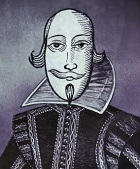Shakespeare Glossary: Y
If you need more information on a particular word or the context in which it is used, please see the play or sonnet in which the word appears for detailed annotations at the bottom of each page.
Also please see Shakespeare's Characters: A to Z. Here you will find a comprehensive list of every Shakespearean character and the play in which he or she appears. Included is our exclusive spelled pronunciation guide, essential for actors and teachers, and an in-depth biography of many of Shakespeare's most popular and fascinating creations.
YARE: ready, nimble, brisk.
YARELY: adv. readily.
YAW: unsteady.
YCLAD: clad, clothed.
YCLEPED: called, named.
YCLIPPED: do.
YEARN: to grieve, vex.
YEDWARD: a form of "Edward".
YELLOWNESS: jealousy.
YELLOWS: jaundice in horses.
YEOMAN: a sheriff's officer.
YERK: to thrust or push.
YEST: foam on disturbed water.
YESTY: foamy; frothy.
YEW: a tree frequently planted in churchyards. The wood is poisonous.
YIELD: to bring forth; to reward.
YORE: once upon a time.
YOKE: pair of oxen; to be combined, coupled.
YOND: yonder.
YOUNKER: novice.
YRAVISH: to ravish.
YSLAKED: to silence; to renender inactive.
|
Notes on Shakespeare
 A writer uses satire to criticize social vices and absurdities. How does Shakespeare shape the character of Osric to satirize the ostentatious dress and obsequious nature of a typical courtier? How does Hamlet's metaphor based on the brewing process (5.2) reinforce the image of courtiers as a frivolous group of sycophants that crumble under pressure? Note yesty means "foamy" or "frothy." Read on...
A writer uses satire to criticize social vices and absurdities. How does Shakespeare shape the character of Osric to satirize the ostentatious dress and obsequious nature of a typical courtier? How does Hamlet's metaphor based on the brewing process (5.2) reinforce the image of courtiers as a frivolous group of sycophants that crumble under pressure? Note yesty means "foamy" or "frothy." Read on...
____
Henry Bolingbroke, the eldest son of John of Gaunt and the grandson of King Edward III, was born on April 3, 1367. Henry usurped the throne from the ineffectual King Richard II in 1399, and thus became King Henry IV, the first of the three kings of the House of Lancaster. Read on...
____
An atomy is the smallest particle of matter (an atom). The most famous use of the word atomy in the plays is found in Mercutio's Queen Mab speech in Romeo and Juliet (1.4)
____
Shakespeare acquired substantial wealth thanks to his acting and writing abilities, and his shares in London theatres. The going rate was £10 per play at the turn of the sixteenth century. So how much money did Shakespeare make? Read on...
Twenty-four of Shakespeare's sonnets are addressed to a woman. We have little information about this woman, except for a description the poet gives of her over the course of the poems. Shakespeare describes her as 'a woman color'd ill', with black eyes and coarse black hair. Thus, she has come to be known as the "dark lady." Find out...
____
"Hamlet, a young Danish prince, accompanied by his friend Horatio, stands by a low wall that encloses a graveyard watching an old sexton who is digging a grave. With professional unconcern the old fellow shovels out the earth, together with some human bones; amongst them two skulls, one of which he strikes smartly with his spade to imbed it in the soft earth, and prevent its rolling away." Frederick Warde. More on Yorick...
____
Eleanor of Aquitaine was one of the most captivating and complex figures in history. In 1152, Eleanor married Henry Plantagenet (later to become Henry II). Their son, John, was born in 1167 and is the title character of Shakespeare's history play. Take a Shakespeare history quiz...
|
|
 A writer uses satire to criticize social vices and absurdities. How does Shakespeare shape the character of Osric to satirize the ostentatious dress and obsequious nature of a typical courtier? How does Hamlet's metaphor based on the brewing process (5.2) reinforce the image of courtiers as a frivolous group of sycophants that crumble under pressure? Note yesty means "foamy" or "frothy."
A writer uses satire to criticize social vices and absurdities. How does Shakespeare shape the character of Osric to satirize the ostentatious dress and obsequious nature of a typical courtier? How does Hamlet's metaphor based on the brewing process (5.2) reinforce the image of courtiers as a frivolous group of sycophants that crumble under pressure? Note yesty means "foamy" or "frothy."